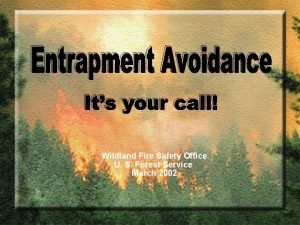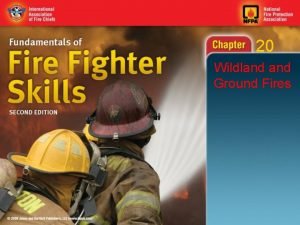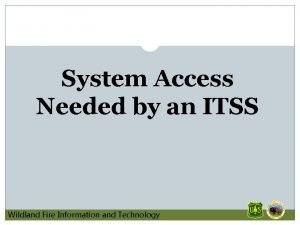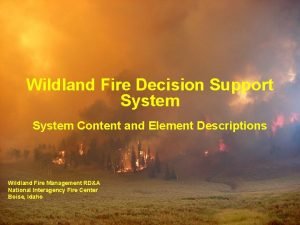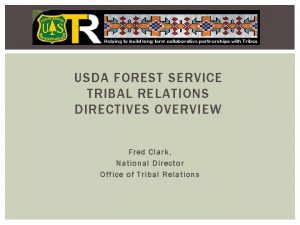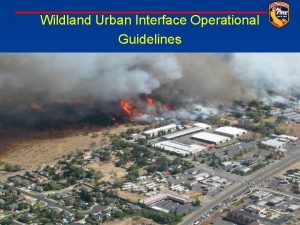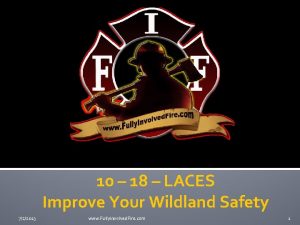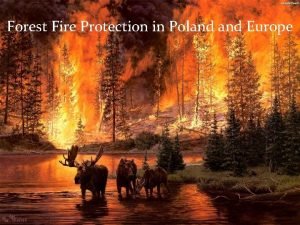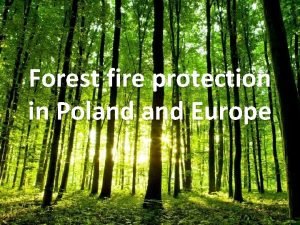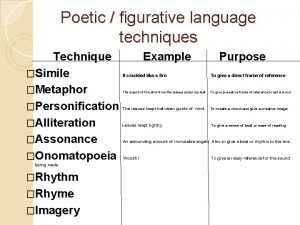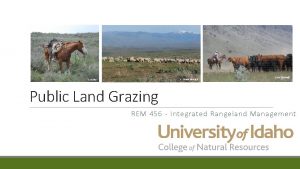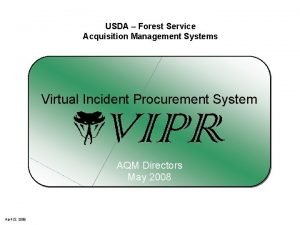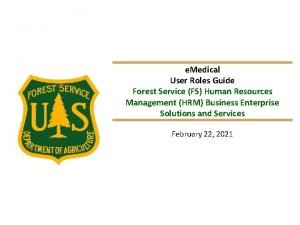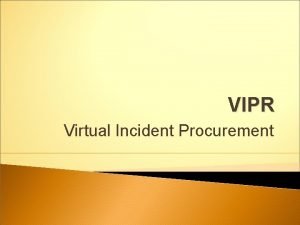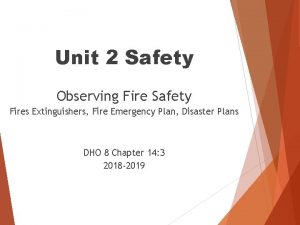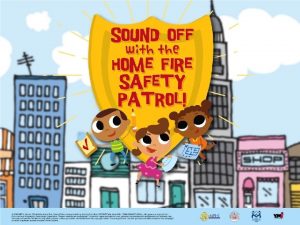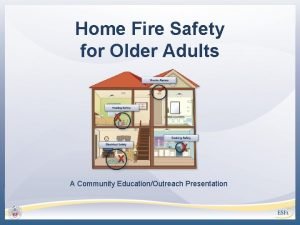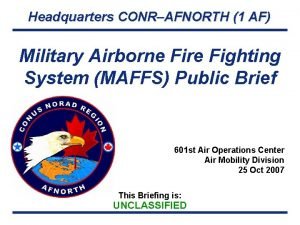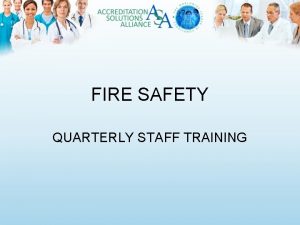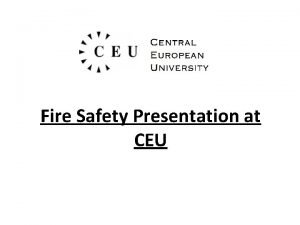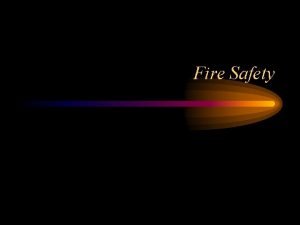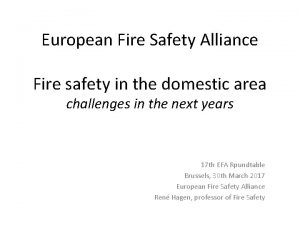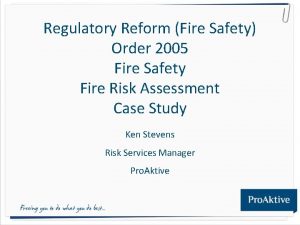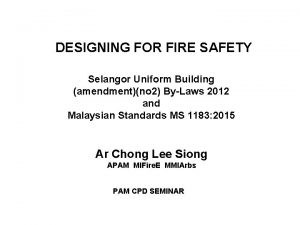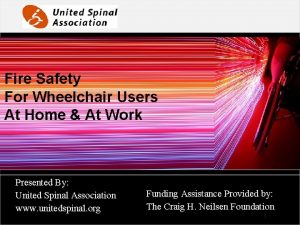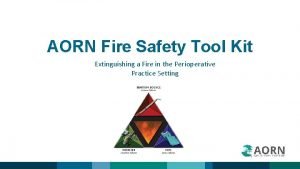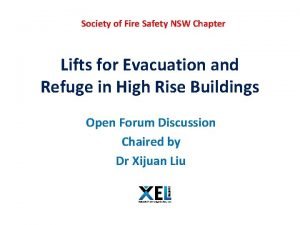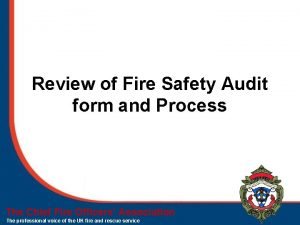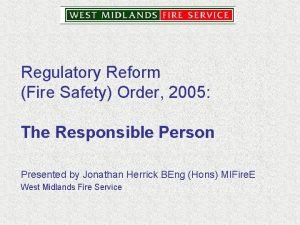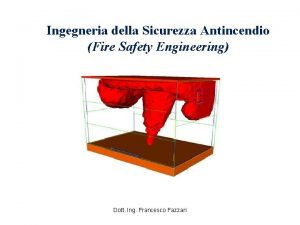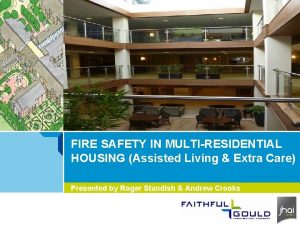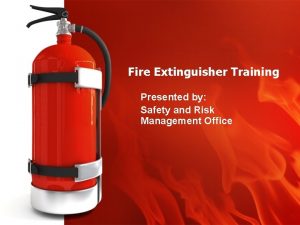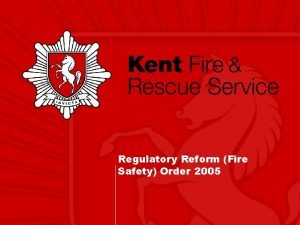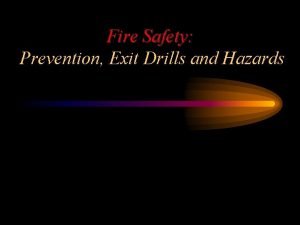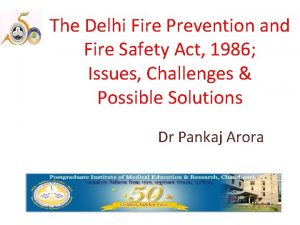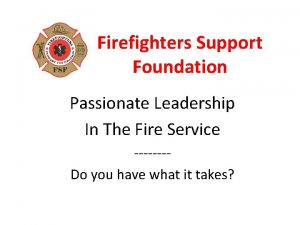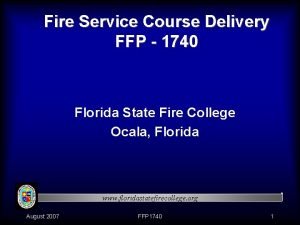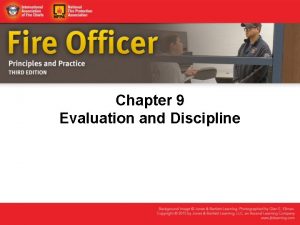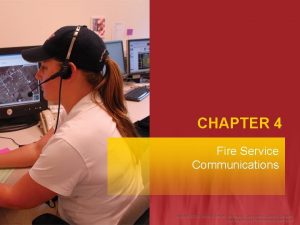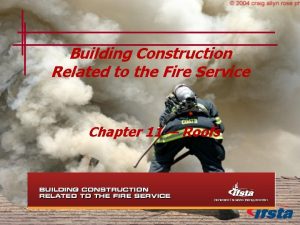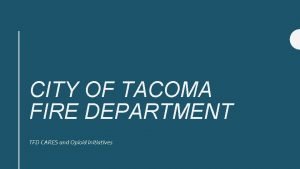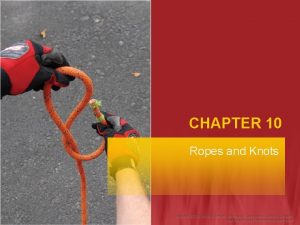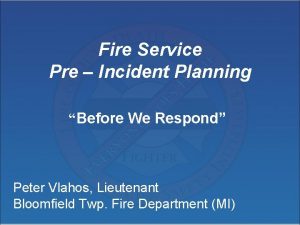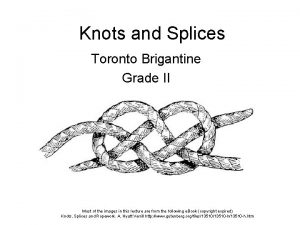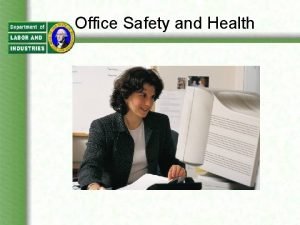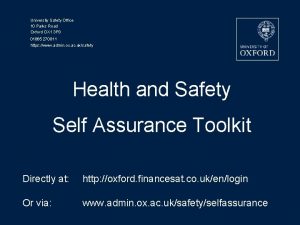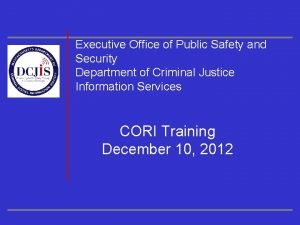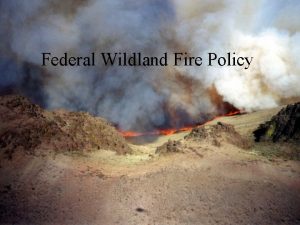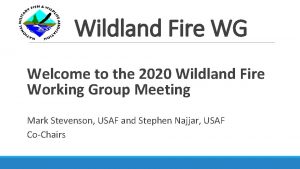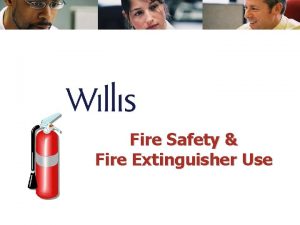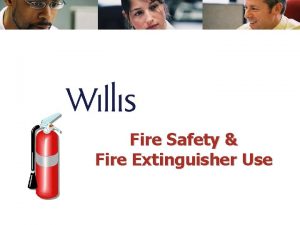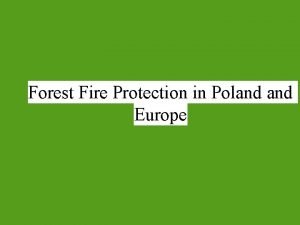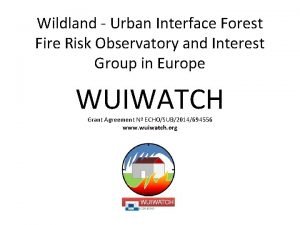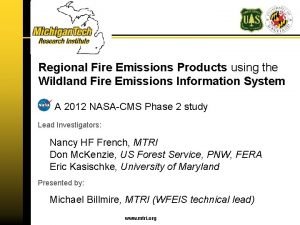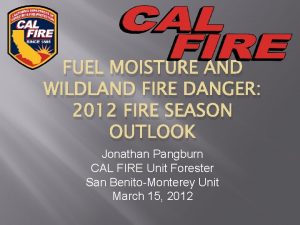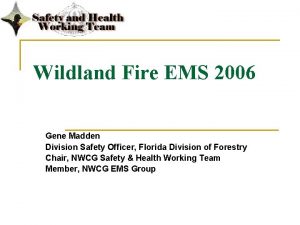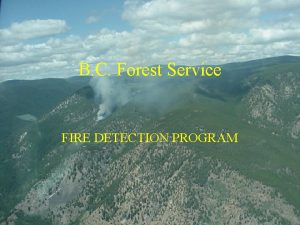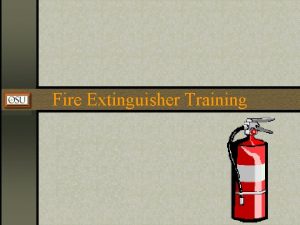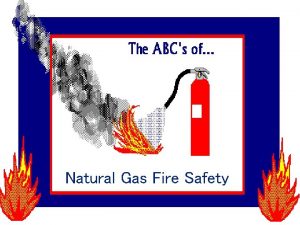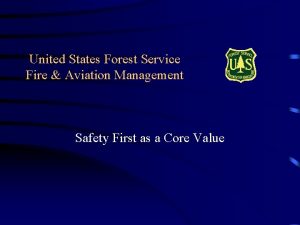Wildland Fire Safety Office U S Forest Service

































































- Slides: 65

Wildland Fire Safety Office U. S. Forest Service March 2002

Objectives Part 1 Decision-making Ø Describe the role that LCES has in the Risk Management Process. Ø Describe a protocol for negotiating an unsafe assignment. Ø Define Trigger Point and Levels of Engagement. Ø Given a set of fireline conditions, identify valid trigger point(s).

Objectives Part 2 Recognition Ø Describe a procedure for recognizing escape routes and safety zones when engaging a fire. Ø Given a set of fireline conditions, estimate minimum safety zone size.

Objectives Part 3 The Human Factor Ø Identify human factors that contribute to fireline decision errors. Ø Given a fire scenario, determine the appropriate level of engagement as conditions change.

Where do we start? v What skills do we use to avoid entrapment?

Escape & Safety Ø Concept of escape has been in the firefighting profession long before there were defined Rules of Engagement. Ø The really smart leader of firefighters has an escape and safety contingency plan in place before deciding to engage a fire!


Key Decision Points Ø Avoiding entrapment on the fireline is all about deciding when and where you engage the fire. • Accepting a new assignment and engaging the fire with planned suppression actions. • Continuing those suppression actions when there is a change in the fireground situation. I need your crew to punch an indirect line down this ridge and through that saddle.

Risk Decision for Engaging a Fire New Fireline Assignment Decision Point Engage fire with planned assignment Negotiate assignment Turn down assignment

Rules of Engagement Ø Defined Rules of Engagement have been a part of firefighting doctrine since 1958. Ø For better or worse, firefighting has become more complex and so have the Rules of Engagement.

Risk Management Ø The Risk Management Process is simply a procedural approach to using the Rules of Engagement that you already know. Ø This process provides the criteria to support your decision-making on the fireline.

What about LCES? v Is LCES all you need to know? v How does LCES relate to the Fire Orders? v What role does LCES have in the Risk Management Process?

Right to know? v Federal law says all workers have the right to know about the hazardous materials they work around…what questions do all firefighters have the right to know the answers to?

Is there legitimate dissent? v Do leaders have a responsibility to protect their firefighters from unnecessary risk? v Have you ever been given a fire assignment that you thought was unsafe or excessively risky? v How did you resolve that situation?

Risk Decision for Changing Situations New Fireline Assignment Decision Point Engage fire with planned assignment Negotiate assignment Turn down assignment Situation Change = Trigger Point? Decision Point Continue full engagement Hold in place Change tactics Disengage and retreat Lookout observation Communication

Trigger Points Ø A pre-identified or anticipated event (time, place, or condition) that, when it occurs, initiates a pre-planned response. Ø Hitting a Trigger Point means stop, evaluate the situation, and make a decision. Ø Step 5 - Evaluate of the Risk Management Process. Situation Change = Trigger Point? Decision Point

Trigger Points are Anticipated Ø Ask yourself “What changing factor(s) can affect our mission success and safety today? ” • Trends in weather? • Changes in fuel type and terrrain? • Tactical progress? • Logistical support?

Trigger Point examples? Fire Environment Fire Operations

Are all Trigger Points created equal? v Trigger Points will vary by geographic area and fuel type…what things should you do on a fire so you are able to identify valid Trigger Points?

EXERCISE: Using Trigger Points Ø Establish Trigger Point(s) when potential exists for your fire situation to degrade. Ø Insure that your situation awareness includes monitoring factors that relate to the Trigger Point(s) you set. Ø Have a planned response in place for your actions when a Trigger Point is hit. Ø Do not ignore a Trigger Point that has been hit! q“Trigger Point” exercise

EXERCISE: Using Trigger Points Your Assignment • It is August 23 rd and you have been dispatched as the initial attack Incident Commander for the Davis Fire. • The fire is located in the Northern Rocky Mountains in Montana • You have a hotshot crew and two Type 3 engines assigned to

EXERCISE: Using Trigger Points Local Factors • Fires you have worked here in Montana over the last couple of weeks have burned quite actively after 1400. • Todays weather forecast: Max Temp near 90º Min RH 18 -20% NW winds to 15 mph

EXERCISE: Using Trigger Points Fire Situation • You have arrived at the fire and have a safe anchor point to work from. • The fire is about 3 acres. • The fire currently has a moderate of spread in surface fuels. • Time is 1030.

EXERCISE: Using Trigger Points What are your Trigger Point(s)?

EXERCISE: Using Trigger Points One possible answer!

Levels of Engagement Ø What do you do when a Trigger Point is hit: Situation Change = Trigger Point? • Validate continuing with full engagement of the fire…or • Implement your preplanned response. Contingency plan Plan B Decision Point Continue full engagement Hold in place Change tactics Disengage and retreat

Hold in Place Ø Stop advancing or pull back a short distance. • Buys time to re-assess. • Fireline can be improved. • Troops can regroup. • Escape time can be shortened. • Allows for faster reengagement. Let’s hold up here. If the wind switches back, we’ll go after it again.

Change Tactics Ø Disengage from the fire, change tactics, and reengage the fire. • Line location can be improved. • Hazardous areas can be avoided. • Direct versus indirect line can be considered. • Negotiate changes within the chain of command. I think we need to move back under it and go direct.

Disengage & Retreat Ø Move directly to a safety zone. • Immediate and full activation of all components in the LCES system. • Extreme situations may require crews to drop gear in order to move faster. Reverse tool order and move back to the safety zone now!

Leader’s responsibilities? v What responsibilities do leaders have when they initiate a change in the level of engagement on a fire?


Escape Route & Safety Zone Recognition Ø We have been talking about decision-making: When to engage the fire? When to disengage? Ø How do we recognize effective escape routes and safety zones so we can make those decisions?

A Process to Use Ø Observe the area Ø Visualize fire spread Ø Identify valid safety zones Ø Time the escape Ø Inform others Ø Evaluate conditions

Observe Ø Personally observe potential safety zones and escape routes in the work area. Ø Step 1 – Situation Awareness of the Risk Management Process.

Visualize Ø Build a mental picture of the fire behavior you would expect if conditions existed that would enable a crown fire to burn around your potential safety zone. • Anticipate flamelengths. • Anticipate convective influences.

Identify Ø Compare the fire behavior you visualize with the size and location of potential safety zones you observe in order to identify any true safety zones available. Ø We will look at safety zone selection in more detail.

Time Ø Have someone walk and time the route from the work location to the potential safety zone(s). Ø We will look at escape time in more detail.

Inform Ø Communicate the location and path of travel to those who work for you and around you. Ø Flag or otherwise mark if the escape route or safety zone is not obvious.

Evaluate Ø You must continually evaluate your escape and safety plan to insure that it will still work. • Time of day and fire intensity changes. • Tactical progress and travel distance changes. • Step 5 - Evaluate of the Risk Management Process.

What is a Safety Zone? v What are the requirements for an effective safety zone?

Do you know where your Zone is? v What are three primary types of safety zones? Discuss some examples and advantages/disadvantages of each.

Location, Location Ø Heavy fuels? Ø Downwind? Ø Above the fire, in a chimney, or in a saddle? OR Ø Fine fuels and burnout? Ø Flank of the fire? Ø Lowest ground?

Radiant vs. Convective Heat? v Convective influences can push lethal heat to surprising distances and increase safety zone size requirements…what are these influences?

EXERCISE: Estimating Safety Zone Size Ø This model was developed by the Missoula Fire Lab. Ø This model considers the heat impact from RADIANT HEAT only…thus it provides a tool to estimate MINIMUM safety zone size. q“Safety Zone Size” exercise

EXERCISE: Estimating Safety Zone Size Your Assignment It is October 3 rd and your 20 person crew has been working on the 3000 acre Madre Fire for two days. • The fire is located in the Coast Range of Southern California. • Your crew is one of four handcrews assigned to the Division C. •

EXERCISE: Estimating Safety Zone Size Local Factors The fire is burning in chaparral about 10’ tall. • For the last two days you have observed 20’ flame heights on upslope runs during the peak of the burning period. • It is 0700, conditions are the same today and you are anticipating the •

EXERCISE: Estimating Safety Zone Size Fire Situation The four crews in Division C are to construct indirect handline up a ridge to tie into a dozer line on top. • The fire edge has not yet become established in the drainage adjacent to the proposed line location. • You anticipate the fire will continue to make •

EXERCISE: Estimating Safety Zone Size Proposed Safety Zone You are at the anchor point which is an area at the base of the ridge that has been cleared by a dozer. • The cleared area is flat and about 200 feet wide by about 300 feet long. • Brush surrounds the cleared area on all sides. •

EXERCISE: Estimating Safety Zone Size Will it work for a Safety Zone?

EXERCISE: Estimating Safety Zone Size Let’s Do the Math! Using the Missoula Fire Lab model on page 7 in the Incident Response Pocket Guide you calculate that:

EXERCISE: Estimating Safety Zone Size It’s Never Black and White! This is only an exercise to get you to think about safety zone criteria. Everyone painted a different mental picture of this situation based on their experience. But you all should have considered the following:

What is an Escape Route? v What are the requirements for an effective escape route?

How far is it, anyway? v How do you calculate escape time?

Uphill Escape Routes Ø Avoid steep uphill escape routes. Ø Firefighter travel rates are significantly slower. Ø Remember the smart firefighter knows that fire goes faster uphill and people go slower!

Safety Margin Ø Your Safety Margin is simply the time you estimate it will take the fire to spread to your location…. minus your known escape time. Ø This number needs to be a positive number!

Safety Margin Paradox Ø Firefighter escape time will increase during the burning period (fireline progress and fatigue) Ø Fire rate of spread will increase during the burning period (typically warmer, drier, windier). Ø Safety Margin will decrease!

Safety margin minimum? v How far away from my safety zone can I be and still have a positive safety margin?

Adjusting LCES Ø When safety margins shrink below 5 minutes, it should be considered a standard Trigger Point. Ø Conditions on fires seldom remain constant, you may need to adjust any or all parts of your LCES system several times during a shift to reflect changing conditions.


Escape and Safety Decision Paths Lookout observation Situation Change = Trigger Point? Decision Point Communication Continue full engagement Hold in place Change tactics Disengage and retreat No Escape Route in Place ? ? Select a Deployment Site ? -------? Last resort survival ? ? ? Normal Escape Cut Off ? ? ? • Failure to establish LCES ? ? ? -------Last resort survival ? ? ? Safety Zone -------Life is good Inadequate Safety Zone ? ? -------Deploy fire shelter ? Select a Deployment Site ? Normal Escape ? ? • Safety zone size estimation error • Lookout observation error • Communication of disengagement alarm error • Escape time estimation error

Fires Don’t Kill Firefighters Ø Firefighter decision errors kill firefighters…so we’re back to decision-making! Ø As you have just seen 4 things can happen when you have to implement your escape and safety plan… 3 of them are bad. Ø Your decision-making and communication skills as a leader will determine the outcome.

Entrapments = Decision Errors v Where do entrapments most frequently occur? v Who is most frequently involved? v When do entrapments typically happen? v Why do entrapments happen?

Practice Scenarios Ø Tactical Decision Game – Alaska Ø Video Case Study – Colorado

Field Drills Ø Establish and practice your crew’s standard operating procedure for disengage and retreat. Ø Practice field recognition of viable safety zones. Ø Use a watch to time uphill and downhill travel rates. Ø Estimate slope percentage and check with a clinometer. Ø Estimate flame heights and use a watch to time fire runs.

The Bottom Line Ø This training session was an opportunity for each of us to assess how we approach firefighter safety and a forum to learn from others. Ø No rules, standards, policies, or checklists will ensure your safety on the fireline. Ø Maintaining awareness of your situation and using fundamental firefighting methods are the foundation for safe and effective fireline operations.
 Trigger points wildland fire
Trigger points wildland fire Pincer attack wildland fire
Pincer attack wildland fire Ftp wildland fire
Ftp wildland fire Wfdss training
Wfdss training Fire hose reel signage standards
Fire hose reel signage standards Forest service directives
Forest service directives Draw d wildland
Draw d wildland Laces wildland
Laces wildland Fire in forest
Fire in forest Fire in forest
Fire in forest Is personification a metaphor
Is personification a metaphor Reichstag fire who was the fire starter
Reichstag fire who was the fire starter Damper interface panel
Damper interface panel Ire fire fire rwi
Ire fire fire rwi Race fire
Race fire Us forest service
Us forest service Vipr forest service
Vipr forest service Connect hr emedical
Connect hr emedical Virtual incident procurement
Virtual incident procurement Test del escalon del forest service
Test del escalon del forest service Fire needs 3 things
Fire needs 3 things Home fire safety patrol
Home fire safety patrol European fire safety community
European fire safety community Military fire safety
Military fire safety Race fire safety
Race fire safety Ceu catch a fire
Ceu catch a fire Fire safety objectives
Fire safety objectives Fire safety training powerpoint
Fire safety training powerpoint European fire safety community
European fire safety community Fire risk assessment aorn
Fire risk assessment aorn Regulatory reform fire safety order 2005
Regulatory reform fire safety order 2005 Paul nelis fire safety
Paul nelis fire safety What is the pass system in culinary
What is the pass system in culinary Travel distance ubbl
Travel distance ubbl Persuasive quick write prompts
Persuasive quick write prompts Wheelchair fire escape
Wheelchair fire escape Chapter 14:3 observing fire safety
Chapter 14:3 observing fire safety Aorn fire risk assessment tool
Aorn fire risk assessment tool Welding safety program
Welding safety program Society of fire safety
Society of fire safety Fire safety audit form
Fire safety audit form The regulatory reform (fire safety) order 2005 summary
The regulatory reform (fire safety) order 2005 summary Ingegneria sicurezza antincendio
Ingegneria sicurezza antincendio Nfcc fire safety in specialised housing
Nfcc fire safety in specialised housing Brainpop jr fire safety
Brainpop jr fire safety Fire safety in extra care
Fire safety in extra care Fire extinguisher
Fire extinguisher Regulatory reform (fire safety) order 2005 article 8 to 23
Regulatory reform (fire safety) order 2005 article 8 to 23 Aorn fire safety
Aorn fire safety Delhi fire service act 2007
Delhi fire service act 2007 Leadership in the fire service powerpoint
Leadership in the fire service powerpoint Fire service course delivery
Fire service course delivery What are the two sides of fire service discipline?
What are the two sides of fire service discipline? Chapter 4 fire service communications
Chapter 4 fire service communications Building construction related to the fire service
Building construction related to the fire service Fire extinguisher service tacoma
Fire extinguisher service tacoma Types of ropes used in the fire service
Types of ropes used in the fire service Ericpd fire service
Ericpd fire service Pre incident planning in the fire service
Pre incident planning in the fire service Moodle for hants fire service
Moodle for hants fire service Rolling hitch fire service
Rolling hitch fire service Difference between office location and office layout
Difference between office location and office layout Hazard
Hazard Oxford university safety office
Oxford university safety office üdc
üdc Page 38
Page 38
